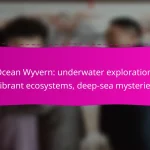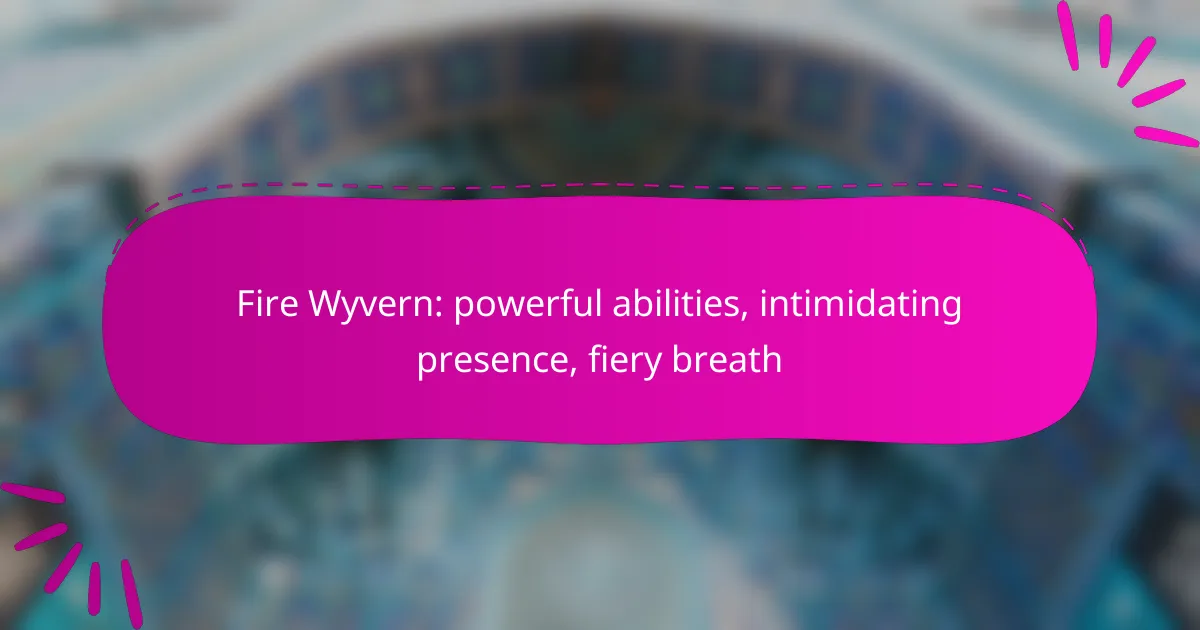Ocean Wyverns are remarkable creatures that thrive in aquatic environments, showcasing adaptations such as streamlined bodies and specialized gills for efficient swimming and oxygen extraction. Their vibrant colors, primarily bright blues and greens, serve crucial roles in camouflage and communication, enhancing their survival in diverse habitats. Additionally, these wyverns possess unique features like enhanced vision and pressure-resistant skin, enabling them to navigate the extreme conditions of the deep sea with ease.
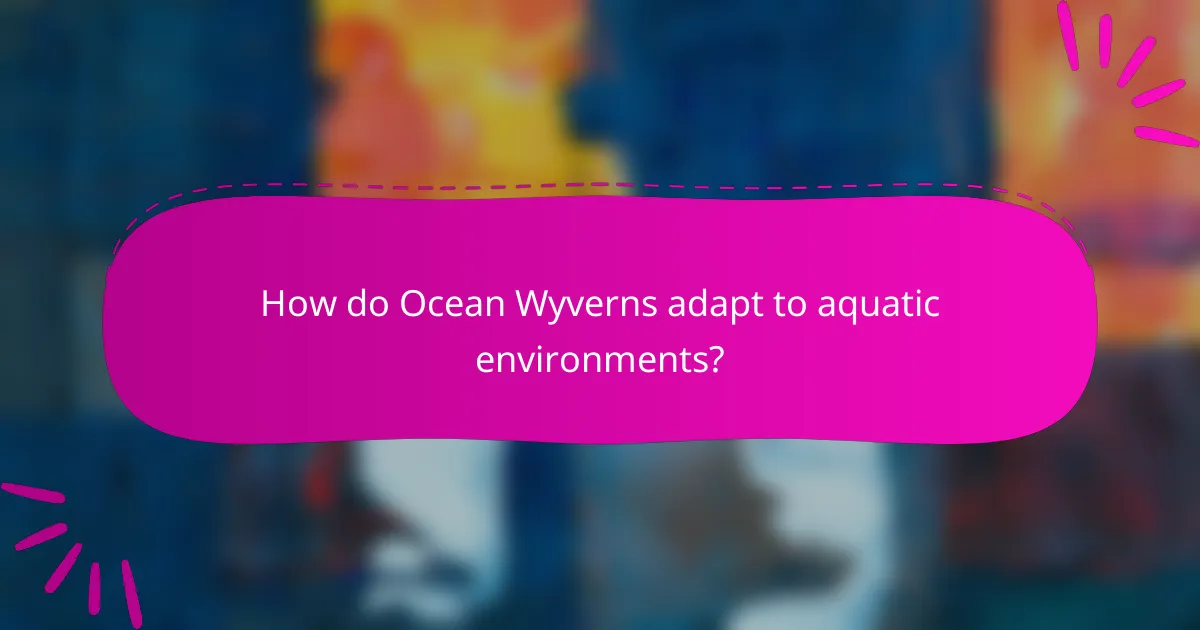
How do Ocean Wyverns adapt to aquatic environments?
Ocean Wyverns exhibit several adaptations that enhance their survival in aquatic environments, including streamlined bodies, specialized gills, and hydrodynamic fins. These features enable them to swim efficiently, extract oxygen from water, and maneuver effectively in deep-sea habitats.
Streamlined body for efficient swimming
The streamlined body of Ocean Wyverns reduces drag as they move through water, allowing for faster and more energy-efficient swimming. This shape is similar to that of other aquatic creatures, such as dolphins and sharks, which have evolved to thrive in marine environments.
Typically, a streamlined body features a tapered head and a narrow tail, which helps the wyvern cut through water with minimal resistance. This adaptation is crucial for hunting prey and escaping predators in the open ocean.
Specialized gills for oxygen extraction
Ocean Wyverns possess specialized gills that enable them to extract oxygen from water efficiently. These gills are highly vascularized, allowing for maximum gas exchange as water flows over them. This adaptation is vital for survival in oxygen-poor deep-sea environments.
Unlike terrestrial creatures, the gills of Ocean Wyverns can filter oxygen even in low concentrations, which is essential for their deep-sea lifestyle. This ability allows them to thrive in various aquatic habitats, from coastal areas to the depths of the ocean.
Hydrodynamic fins for maneuverability
The hydrodynamic fins of Ocean Wyverns are designed for agility and precision in movement. These fins allow for quick turns and changes in direction, which are essential for hunting and evading threats in dynamic underwater environments.
Typically, the fins are broad and flexible, providing both lift and thrust. This design enables Ocean Wyverns to navigate through complex underwater terrains, such as coral reefs and rocky outcrops, enhancing their ability to find food and shelter.
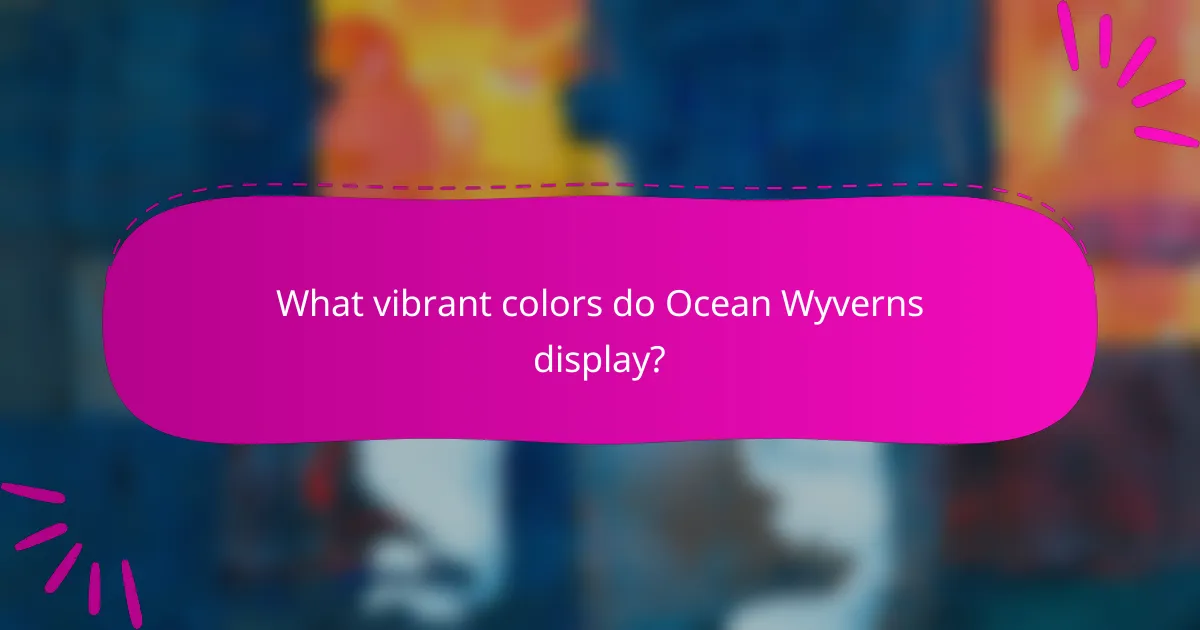
What vibrant colors do Ocean Wyverns display?
Ocean Wyverns exhibit a stunning array of vibrant colors, primarily bright blues and greens, which serve multiple purposes including camouflage and communication. Their coloration is not only visually striking but also essential for their survival in diverse aquatic environments.
Bright blue and green hues for camouflage
The bright blue and green hues of Ocean Wyverns help them blend seamlessly into their oceanic surroundings, particularly among coral reefs and kelp forests. This natural camouflage allows them to evade predators while hunting for prey.
These colors can vary based on the specific habitat, with deeper waters often showcasing darker shades, while shallower areas may present more vivid tones. This adaptability enhances their ability to remain undetected in various marine environments.
Bioluminescent patterns for communication
Ocean Wyverns possess bioluminescent patterns that they use for communication, especially during mating rituals or to signal distress. These glowing patterns can change in intensity and color, allowing for a dynamic form of interaction among individuals.
Typically, these bioluminescent displays are most prominent in darker waters, where they can be seen from significant distances. This ability not only aids in attracting mates but also helps in coordinating group movements or warning others of potential threats.

What are the deep-sea adaptations of Ocean Wyverns?
Ocean Wyverns possess unique adaptations that enable them to thrive in the extreme conditions of the deep sea. These adaptations include enhanced vision for low-light environments and pressure-resistant skin, allowing them to navigate and hunt effectively in the depths of the ocean.
Enhanced vision for low-light conditions
Ocean Wyverns have evolved exceptional eyesight to function in the dimly lit depths of the ocean. Their large, sensitive eyes can detect even the faintest light, which is crucial for spotting prey and avoiding predators in the dark waters.
This enhanced vision is supported by a high concentration of rod cells in their retinas, which are specialized for low-light conditions. As a result, they can see clearly at depths where light penetration is minimal, often exceeding several hundred meters.
Pressure-resistant skin for deep dives
The skin of Ocean Wyverns is uniquely adapted to withstand the immense pressure found in deep-sea environments. This pressure-resistant skin is thick and flexible, allowing them to dive to significant depths without sustaining injury.
Additionally, their skin contains specialized proteins and structures that help maintain structural integrity under pressure. This adaptation not only protects them but also aids in their ability to maneuver through the challenging underwater landscape.
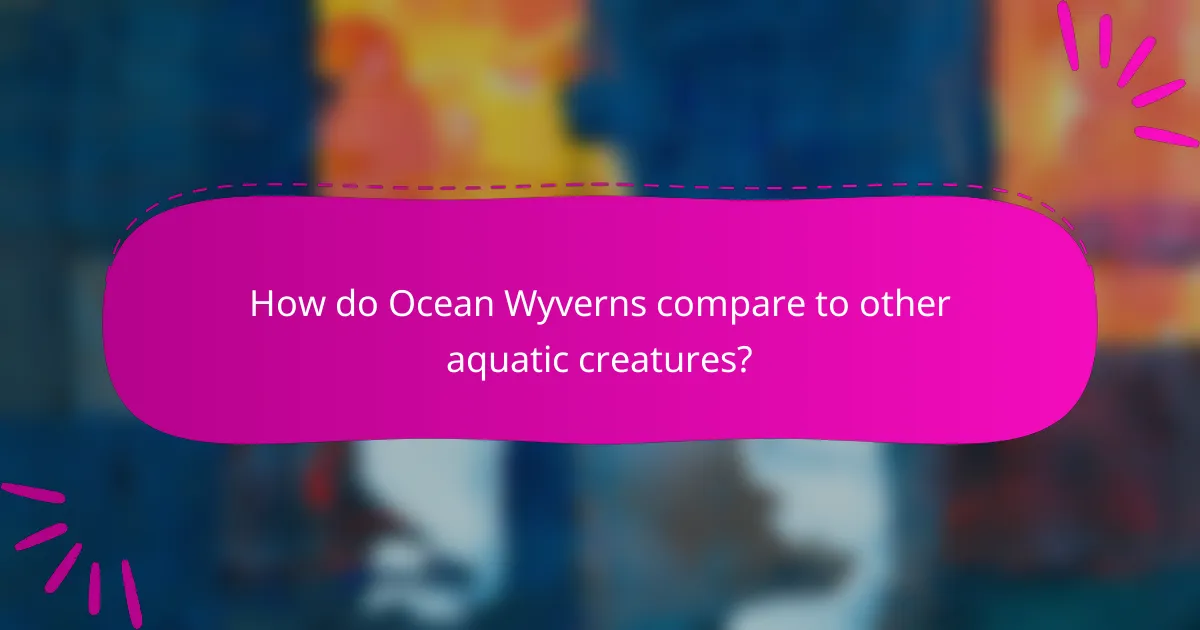
How do Ocean Wyverns compare to other aquatic creatures?
Ocean Wyverns stand out among aquatic creatures due to their unique adaptations and vibrant colors. Unlike many marine animals, they possess features that enhance their ability to thrive in deep-sea environments while showcasing striking hues that serve both camouflage and attraction purposes.
Differences from traditional sea dragons
Ocean Wyverns differ from traditional sea dragons primarily in their physical structure and behavior. While sea dragons are often elongated and resemble seahorses, Ocean Wyverns have a more robust, streamlined body that allows for agile movement through water. Their wings, although not used for flight, help them navigate currents effectively.
Additionally, Ocean Wyverns exhibit a range of vibrant colors that can change based on their surroundings, unlike the more muted tones of sea dragons. This ability not only aids in camouflage but also plays a role in communication and mating displays.
Similarities with deep-sea fish
Ocean Wyverns share several adaptations with deep-sea fish, particularly in their ability to withstand high pressure and low light conditions. Both have developed specialized sensory organs that enhance their perception of the environment, allowing them to detect prey and navigate effectively in the dark depths of the ocean.
Moreover, like many deep-sea fish, Ocean Wyverns possess bioluminescent features that can attract mates or lure in unsuspecting prey. This adaptation is crucial for survival in the often pitch-black waters where they reside.
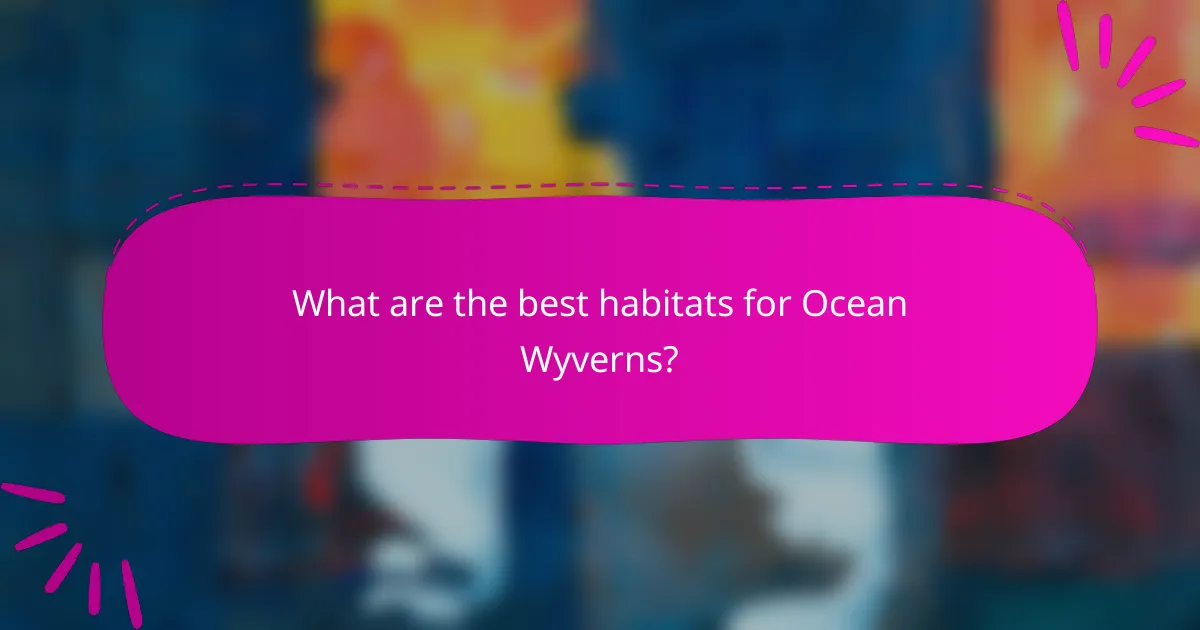
What are the best habitats for Ocean Wyverns?
Ocean Wyverns thrive in diverse aquatic environments, with coral reefs and deep ocean trenches being their primary habitats. These areas provide essential resources for breeding, shelter, and hunting, making them ideal for the survival of this unique species.
Coral reefs as breeding grounds
Coral reefs serve as vibrant breeding grounds for Ocean Wyverns due to their rich biodiversity and abundant food sources. The complex structures of the reefs offer protection for eggs and young wyverns, allowing them to grow in a safe environment.
These ecosystems support a variety of marine life, which in turn attracts Ocean Wyverns. The reefs’ colorful corals and diverse fish populations create an ideal setting for mating rituals and nurturing offspring.
Deep ocean trenches for shelter
Deep ocean trenches provide critical shelter for Ocean Wyverns, offering a refuge from predators and harsh environmental conditions. The extreme depths of these trenches create a stable habitat with cooler temperatures and higher pressure, which some wyverns prefer for resting and hiding.
Additionally, the trenches are rich in nutrients, supporting a unique food web that includes bioluminescent organisms. This availability of food makes deep ocean trenches an attractive habitat for adult Ocean Wyverns seeking sustenance and safety.
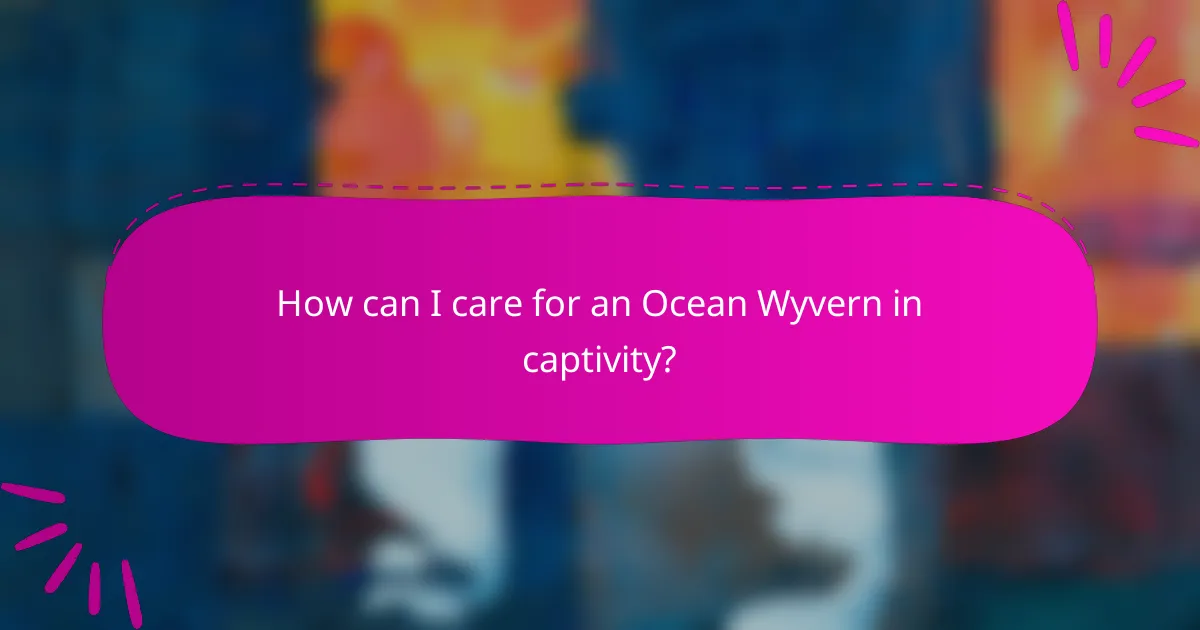
How can I care for an Ocean Wyvern in captivity?
Caring for an Ocean Wyvern in captivity requires a well-maintained aquatic environment, proper diet, and attention to their unique needs. These creatures thrive in spacious tanks that mimic their natural habitat, along with a balanced diet to support their vibrant colors and deep-sea adaptations.
Optimal tank size and environment
An Ocean Wyvern needs a large tank, ideally at least 200 gallons, to accommodate its size and swimming habits. The environment should include plenty of open space, along with structures like rocks and plants to simulate their natural habitat.
Maintain water quality with a filtration system that can handle high volumes, and ensure the temperature stays within a range of 22-26°C (72-79°F). Regular water changes and monitoring of salinity levels are crucial for their health.
Feeding requirements and diet
Feeding an Ocean Wyvern involves providing a varied diet rich in protein. They typically thrive on a mix of high-quality pellets, frozen or live seafood such as shrimp, and occasional plant matter to ensure balanced nutrition.
Feed them multiple times a week, adjusting portions based on their activity level and size. Avoid overfeeding, as this can lead to health issues; a good rule of thumb is to provide an amount they can consume in a few minutes.
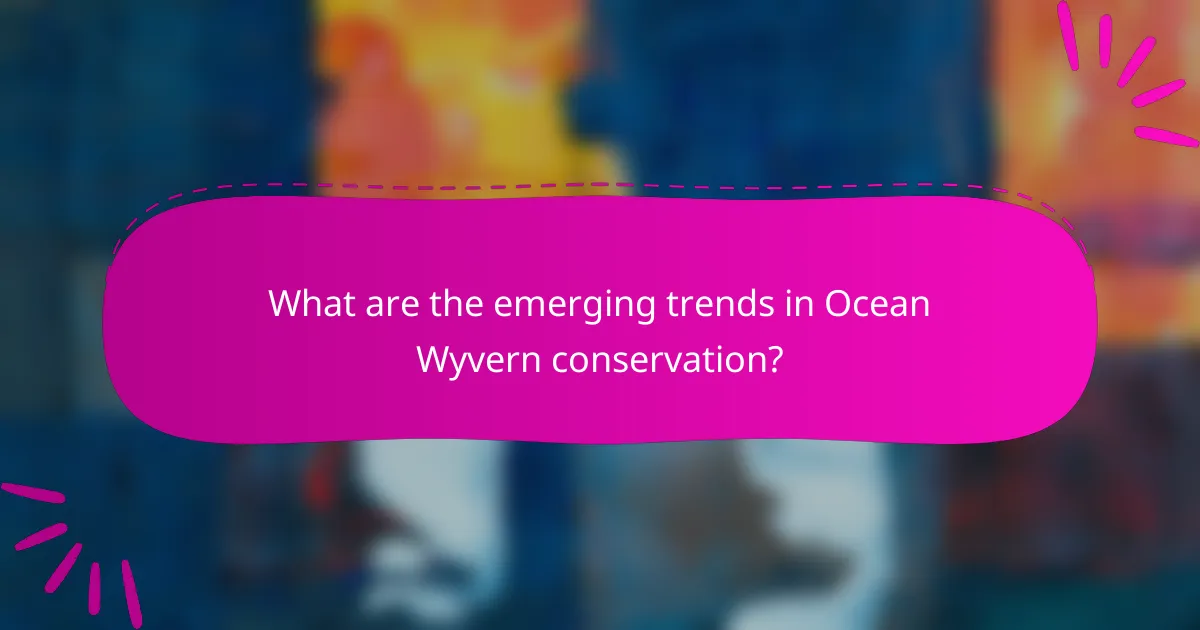
What are the emerging trends in Ocean Wyvern conservation?
Emerging trends in Ocean Wyvern conservation focus on habitat protection, sustainable fishing practices, and public awareness campaigns. These efforts aim to mitigate threats from climate change, pollution, and overfishing, ensuring the survival of this unique species.
Habitat Protection Initiatives
Habitat protection is crucial for the conservation of Ocean Wyverns, as their natural environments are often threatened by human activities. Marine protected areas (MPAs) are being established to safeguard critical breeding and feeding grounds. These zones restrict harmful activities like industrial fishing and coastal development, allowing ecosystems to thrive.
In addition to MPAs, restoration projects are gaining traction. These initiatives focus on rehabilitating damaged habitats, such as coral reefs and seagrass beds, which are essential for the Ocean Wyvern’s survival. Engaging local communities in these efforts can enhance their effectiveness and promote sustainable practices.
Sustainable Fishing Practices
Sustainable fishing practices are vital for maintaining healthy populations of Ocean Wyverns. Regulations that limit catch sizes and promote selective fishing methods help reduce bycatch and protect juvenile Wyverns. Implementing quotas and monitoring fish stocks can ensure that fishing remains within sustainable limits.
Fisheries are increasingly adopting eco-labeling schemes that certify products sourced from sustainable practices. Consumers can support these efforts by choosing certified seafood, which encourages responsible fishing and contributes to the conservation of Ocean Wyverns and their habitats.
Public Awareness Campaigns
Public awareness campaigns play a significant role in Ocean Wyvern conservation by educating communities about the importance of this species and its ecosystem. These campaigns often utilize social media, workshops, and community events to engage the public and foster a sense of stewardship.
Collaborations with schools and local organizations can amplify these efforts, reaching a broader audience. By promoting the ecological significance of Ocean Wyverns and the threats they face, these initiatives can inspire action and support for conservation measures.





